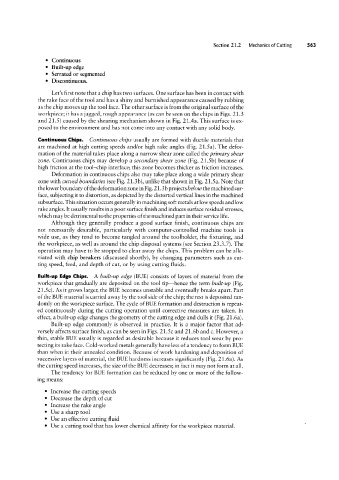Page 582 - 04. Subyek Engineering Materials - Manufacturing, Engineering and Technology SI 6th Edition - Serope Kalpakjian, Stephen Schmid (2009)
P. 582
Section 21.2 Mechanics of Cuttlng
° Continuous
° Built-up edge
° Serrated or segmented
° Discontinuous.
Let’s first note that a chip has two surfaces. One surface has been in contact with
the rake face of the tool and has a shiny and burnished appearance caused by rubbing
as the chip moves up the tool face. The other surface is from the original surface of the
workpiece; it has a jagged, rough appearance (as can be seen on the chips in Figs. 21.3
and 21.5) caused by the shearing mechanism shown in Fig. 21.4a. This surface is ex-
posed to the environment and has not come into any contact with any solid body.
Continuous Chips. Continuous chips usually are formed with ductile materials that
are machined at high cutting speeds and/or high rake angles (Fig. 21.5a). The defor-
mation of the material takes place along a narrow shear zone called the primary shear
zone. Continuous chips may develop a secondary shear zone (Fig. 21.5b) because of
high friction at the tool-chip interface; this zone becomes thicker as friction increases.
Deformation in continuous chips also may take place along a wide primary shear
zone with curved boundaries (see Fig. 21.3b), unlike that shown in Fig. 21.5 a. Note that
the lower boundary of the deformation zone in Fig. 21.3b projects helou/ the machined sur-
face, subjecting it to distortion, as depicted by the distorted vertical lines in the machined
subsurface. This situation occurs generally in machining soft metals at low speeds and low
rake angles. It usually results in a poor surface finish and induces surface residual stresses,
which may be detrimental to the properties of the machined part in their service life.
Although they generally produce a good surface finish, continuous chips are
not necessarily desirable, particularly with computer-controlled machine tools in
wide use, as they tend to become tangled around the toolholder, the fixturing, and
the workpiece, as well as around the chip-disposal systems (see Section 23.3.7). The
operation may have to be stopped to clear away the chips. This problem can be alle-
viated with chip breakers (discussed shortly), by changing parameters such as cut-
ting speed, feed, and depth of Cut, or by using cutting fluids.
Built-up Edge Chips. A huilt-up edge (BUE) consists of layers of material from the
workpiece that gradually are deposited on the tool tip-hence the term built-up (Fig.
21.5c). As it grows larger, the BUE becomes unstable and eventually breaks apart. Part
of the BUE material is carried away by the tool side of the chip; the rest is deposited ran-
domly on the workpiece surface. The cycle of BUE formation and destruction is repeat-
ed continuously during the cutting operation until corrective measures are taken. In
effect, a built-up edge changes the geometry of the cutting edge and dulls it (Fig. 21.6a).
Built-up edge commonly is observed in practice. It is a major factor that ad-
versely affects surface finish, as can be seen in Figs. 21.5c and 21.6b and c. However, a
thin, stable BUE usually is regarded as desirable because it reduces tool wear by pro-
tecting its rake face. Cold-worked metals generally have less of a tendency to form BUE
than when in their annealed condition. Because of work hardening and deposition of
successive layers of material, the BUE hardness increases significantly (Fig. 21.6a). As
the cutting speed increases, the size of the BUE decreases; in fact it may not form at all.
The tendency for BUE formation can be reduced by one or more of the follow-
ing means:
° Increase the cutting speeds
° Decrease the depth of cut
° Increase the rake angle
° Use a sharp tool
° Use an effective cutting fluid
' Use a cutting tool that has lower chemical affinity for the workpiece material.

